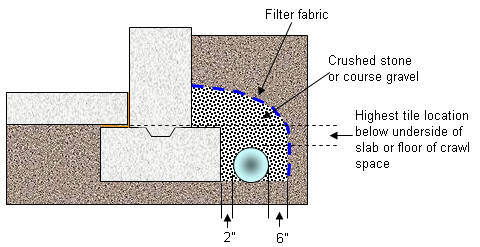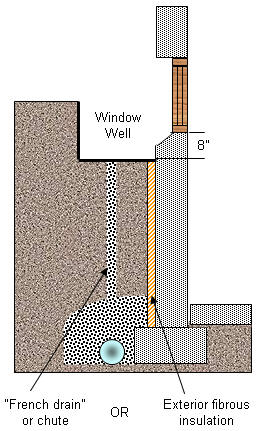Concrete Foundation Walls - Water Leakage
Problem: Water leakage through foundations - 2.
Cause: Improperly installed drainage tile.
Drainage tile will not perform as intended when it is not properly sloped, when it becomes clogged, or when it does not drain water away from the site.
Solutions: Ensure correct installation of drainage tile or a granular drainage layer.
- Leave clearance of 1 1/2 inches to 2 inches (25mm to 50 mm) between the tile and the footing to reduce clogging in this area and to increase the drainage area.
- Set the tile at the bottom of the footing on undisturbed soil or compacted soil. Ensure that the entire drain tile is located below the underside of the basement slob or floor of the crawl space. Cover the drain tile with a minimum of 6 inches (150 mm) of granular material. To prevent the accumulation of silt and fines in the tile, use a filter fabric or glass fiber batt to cover the granular material or the tile itself as shown in Figure 23.

Figure 23 - Weeping-Tile Detail
- Ensure that drainage from window wells is connected to drainage tiles. Prevent water from accumulating at the junction of the footing and the foundation wall. Provide a
French drain
, a veridical gravel- or drainage-material-filled weeper as shown in Figure 24.

Figure 24 - Window-Well Drainage
- Install clean granular material, containing not more than 10% material that will pass through a 1/6 inch (4mm) sieve, to a depth of 5 inches (125 mm) beneath the building, extending not less than 12 inches (300 mm) beyond the outside edge of the footings. The bottom of the excavation sing the granular drainage layer must be sloped so that the entire area is drained to a sump. Sump pits should be at least 12 inches (300 mm) below the level of the floor slab to ensure adequate drainage.
Additional information on French drains
